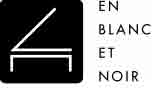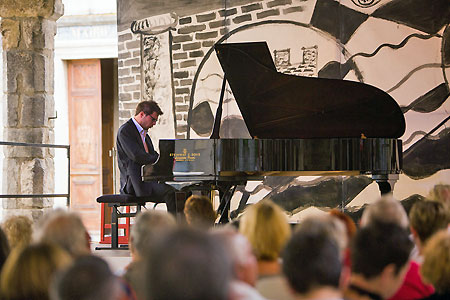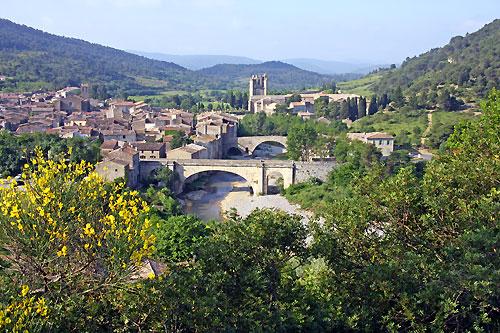 |
| The Independent Traveler's Newsletter PAGE THREE |
 |
| The Independent Traveler's Newsletter PAGE THREE |
|
|
 EBEN: En Blanc et Noir - Lagrasse Piano Festival . . . by Robert Turnbull introduction by Anita Rieu-Sicart In July 2013, Robert Turnbull, professional journalist, graduate of the San Francisco Music Conservatory, and keen amateur pianist, fulfilled a long-cherished dream: to create a piano festival in the village of Lagrasse, some 30 kilometres south-east of Carcassonne, France, giving precious opportunities to several young Americans and Europeans launching careers as concert pianists. Described in the
London Times as ‘the most beautiful village in France’, Lagrasse
attracts an unusual diversity of people during the summer.
The original idea behind the festival was to provide a major opportunity and a beautifull venue for young artists to perform in public. This has been made possible thanks to the hard work and dedication of a small organizing team and good support from the Lagrasse council and several generous donors, attracted to the festival because of its unusual combination of emerging international talent, setting and location. Robert
Turnbull wrote the following about the 2015 Festival.
When a few friends and I created the Piano Festival En Blanc et Noir in the Aude village of Lagrasse, in 2013 our principle aim was to provide opportunities for young pianists at the onset of their careers. The festival began as a humble affair. With a stage just big enough for two grand pianos, minimal lighting and no amplification, it was really a salon en plein air, en pleine lune, a stone’s throw from the Abbaye de Lagrasse, one of France’s most romantic monuments. Musically, we were all surprised by the results. One or two pianists, you could tell, were still finding their form, but the standing ovation inspired by James Kreiling and Janneke Brits’ piano duo version of Stravinsky’s Le Sacre du Printemps gave us all the sense that we are onto something. The talent of over a dozen gifted musicians radiated long after the sounding of the final notes. The experience, we began to realize, must be repeated! James and Janneke, both Guildhall graduates, returned last summer on July 15 for a four-hand arrangement of Debussy’s tone poem La Mer, and - perhaps the most exciting item of the entire festival – the French premiere of Gustav Holst’s recently-discovered arrangement of The Planets Suite. Of course, Holst adored France and spent many days walking in the Auvergne, dreaming up cosmic melodies. 2015 marked the centenary of possibly the 20th century’s most mystifying composer. Alexander Scriabin is perhaps most famous for his eccentric and unexecuted plan to mount musical extravaganzas in a temple in the Himalayas. But for pianists, the technical challenges demanded to conjure his unique sound world are very real. Having written a dissertation on the composer while recording a CD of his music, James Kreiling shared his insights at EBEN this past summer before performing the composer’s 6th and 10th sonatas. The  Serbian-American pianist, Ivan
Ilic, won multiple plaudits for his recordings of Godowsky’s fiendishly
difficult left-hand ‘studies’ on Chopin’s Etudes. He opened
2015’s EBEN with a selection of Scriabin Preludes, sharing the stage
with his pupil Paul Salinier, who played Debussy’s Estampes. Together they ended the
concert as a duo – for Schubert’s Overture in F minor and Debussy’s
rarely heard Divertissement. Serbian-American pianist, Ivan
Ilic, won multiple plaudits for his recordings of Godowsky’s fiendishly
difficult left-hand ‘studies’ on Chopin’s Etudes. He opened
2015’s EBEN with a selection of Scriabin Preludes, sharing the stage
with his pupil Paul Salinier, who played Debussy’s Estampes. Together they ended the
concert as a duo – for Schubert’s Overture in F minor and Debussy’s
rarely heard Divertissement.Responding to the suggestion that the 2014 festival was too Anglophone, I scouted more French talent. François Moschetta, a pupil of Michel Beroff, played Schubert’s great A major Sonata and some Ravel. Guillaume Sigier ([photo), a former RCM student, has also chosen Ravel along with Brahms’ Opus 118 Intermezzi and something by the contemporary British composer Thomas Ades. Louisa Counarie has decided on a program embracing 200 years of the classics: Schubert, Bach, Mozart and Mendelssohn’s sweetly affecting Songs Without Words. Lagrasse has its own resident concert pianist: Charley Felter’s debut for EBEN assembled Preludes by the Catalan composer Mompou, a handful of Chopin Mazurkas and two of his own waltzes. The festival aims to showcase other pianistic skills, which included accompanying. Nestor Bayon returned to accompanying his compatriot, baritone Alex Vicens, in a program of Catalan folk songs, Tosti, and a group of operatic arias ending with Puccini’s bloodcurdling Nessum Dorma. Maybe one of the most attractive aspects is that the concerts are free ~ no conflated prices ~ people just doing it for the love of it, but raising enough money to pay the young musicians. Everyone contributes. This year the Festival is July 2 to 7, 2016, and below are some highlights. EN BLANC & NOIR PIANO FESTIVAL Lagrasse (Aude) FOURTH EDITION 2016!
The Catalan composer Enrique Granados drowned tragically on his return from the première of his opera Goyescas in New York a hundred years ago. EBEN commemorates this great composer by inviting the Barcelona-based pianist Luis Grané López to play his original solo piano version of Goyescas. The work takes inspiration from images by Goya.  We
also mark the 100th anniversary of the birth of French composer Henri
Dutilleux. The Belgian pianist Stephanie Proot makes her EBEN
debut by playing part of his demanding solo piano sonata, balanced by
the bewitching charm of the A major Schubert sonata, D.664. We
also mark the 100th anniversary of the birth of French composer Henri
Dutilleux. The Belgian pianist Stephanie Proot makes her EBEN
debut by playing part of his demanding solo piano sonata, balanced by
the bewitching charm of the A major Schubert sonata, D.664.The piano is bigger than the classics, all the same, and this year EBEN is thrilled to launch a Cabaret Evening featuring singers Kate Symonds-Joy and Alexey Gusev and violinist Lev Atlas. Accompanied by Yshani Perinpanayagam and Stephen Adam, they will “welcome-willkommen-bienvenue” us through a selection of French chansons, as well as German and British cabaret songs by Weill, Poulenc, Brel and Britten. But the whole point is young musicians, Americans, French, European, are getting a chance to get lift off, exposure, in the very competitive professional world of concert performers. The black and white backdrop to this incredibly, country style, under the market canopy is by a British artist Jonathon Brown, a friend of Robert Turnbull. If you go to the web site there are details on how to contribute: www.enblancetnoir.com and Facebook at https://www.facebook.com/En.Blanc.Et.Noir.Lagrasse The En Blanc et Noir piano festival has been gently expanding at a time when many French festivals are closing down. Run by local villagers, the yearly host to a dozen or so international musicians on the cusp of exciting careers, EBEN boasts perhaps the most ravishing venue in the South of France in the 14th century Place de la Halle, smack in the middle of what the London Times described as “France’s most beautiful village’’. Lagrasse is famous for its warmth and conviviality (and the Abbey of St Mary of Lagrasse dating from the 7th century), and our festival has rightly acquired a reputation for its family feel between the artists themselves as well as with the loyal audience. Guest artists and audience members mingle freely, while village volunteers put on lavish banquets in what has become a celebration of local pride and endeavor unparalleled in this region of France.
The Var Village Voice in Provence, the local English-language publication that covers everything of interest and importance in the Var département . Visit her web site to subscribe!
SPONSORING THIS ISSUE
See video of autumn at La
Borde of your favorite memories of France. Luxurious rooms, excellent breakfasts and dinners, award-winning gardens, a fine pool, spa and a host and hostess who are just delightful! Visit them today with a click on the photo, and be sure to watch the video!
|
|
 previous
page
next page
previous
page
next page  |
|